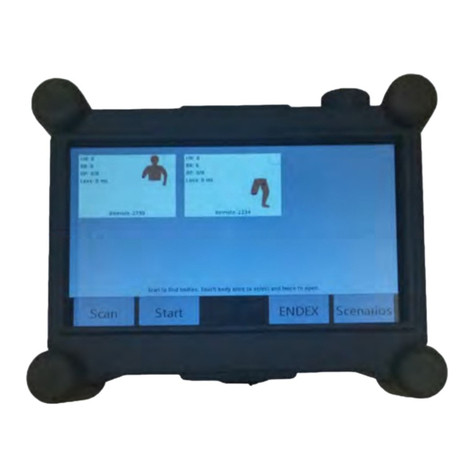TRAUMA F/X EMITT-ASL User manual

EMERGENCY MEDICAL TRAUMA TRAINER – ACTIVE
SHOOTER LOWER (EMITT-ASL)
______________________________________________________
Emergency Medical Trauma Trainer –
Active Shooter Lower (EMITT-ASL)
User Guide
Rev_Q4_2020_TSR

© Copyright 2020. TraumaFX Solutions
Rev_Q4_2020_TSR

© Copyright 2020 TraumaFX Solutions
TraumaFX®
Emergency Medical Trauma Trainer – Active
Shooter Lower (EMITT-ASL)
TraumaFX Customer Service
1-800-200-7465

TABLE OF CONTENTS
i
Chapter1:Introduction....................................................................1
AbouttheEmergencyMedicalTraumaTrainer–ActiveShooterLower............1
ItemChecklist.....................................................................................................2
StandardComponents................................................................................................................2
OptionalComponents................................................................................................................3
SystemOverview................................................................................................3
SpecialNotesandCautions.................................................................................4
LatexAllergyAlert.......................................................................................................................4
AfterUseCare............................................................................................................................4
WaterResistanceandCleanup...................................................................................................5
PossibleReactiontoSyntheticBloodMix..................................................................................5
SystemWeight............................................................................................................................5
SimulatedBlood.........................................................................................................................5
RadioControl..............................................................................................................................5
ThirdPartyUserManuals...........................................................................................................6
Storage........................................................................................................................................6
Compliance.................................................................................................................................6
Chapter2:EmergencyMedicalTraumaTrainer–ActiveShooter
LowerFeatures................................................................................7
Ruggedized,RealisticSyntheticSkin...................................................................7
Material......................................................................................................................................7
PackableHemostaticWound......................................................................................................7
GunshotWound.........................................................................................................................7
TibialI/OSiteonLeftLeg............................................................................................................7
Crepitus......................................................................................................................................8
CautionsandCare.......................................................................................................................8
Materials.....................................................................................................................................8
BleedingSystem.................................................................................................8
Chapter3:GettingStarted............................................................10
NotesonGeneralUseandCare........................................................................10
ChargingtheBatteries......................................................................................10
EMITT‐ASL&TSRTransmitterBatteries...................................................................................10
GeneralUseandCareofBatteries....................................................................11
InstallingandRemovingtheBatteries..............................................................12
InstallingtheEMITT‐ASLBattery..............................................................................................12
RemovingtheEMITT‐ASLBattery.............................................................................................12
InstallingandRemovingtheTSRTransmitterBattery..............................................................13
AttachinganOptionalTraumaFX®UpperUnittotheEMITT‐ASL.....................13
AttachingtoaTraumaFXUpperUnit.......................................................................................13
UsingtheEMITT‐ASLwithaLiveActor.............................................................14

TABLE OF CONTENTS
ii
SimulatedBleeding...........................................................................................15
PrimingtheHoseandBloodSystem.........................................................................................15
MixingtheTraumaFX®BloodPowder......................................................................................17
Filling/RefillingEMITT‐ASLwithBlood......................................................................................17
ApplyingBloodPaste................................................................................................................18
InsertingtheInfusibleTibialIOSkin/BonePlug................................................18
Chapter4:OperatingtheEmergencyMedicalTraumaTrainer–
ActiveShooterLower(EMITT‐ASL).................................................20
Power...............................................................................................................20
SyncandAnimatronicsCheck...........................................................................20
TourniquetApplicationandPressurePoints.....................................................21
Cleaning............................................................................................................21
CleaningtheInletBloodFilter..........................................................................22
Packing.............................................................................................................23
Chapter5:AfterUseCare.............................................................24
Chapter6:Troubleshooting&Repair............................................25
AdditionalSupport....................................................................................................................26
HowtoRepairtheEMITT‐ASLSkin...................................................................27
O‐RingProceduresandReplacement...............................................................28
MaintainingO‐Rings.................................................................................................................28
WhentoReplaceanO‐Rings....................................................................................................28
AppendixA–EMITT‐ASLTechnicalSpecs.......................................29
EMITT‐ASLLowerUnit......................................................................................29
MakitaDC18RCBatteryCharger.......................................................................29
TouchscreenRemoteControlTransmitter........................................................29
AppendixB–SafetyDataSheets....................................................31
BloodPasteSDS................................................................................................32
BloodPowder...................................................................................................35
LithiumBatterySDS..........................................................................................42
Table of contents
Other TRAUMA F/X Medical Equipment manuals
Popular Medical Equipment manuals by other brands

Getinge
Getinge Arjohuntleigh Nimbus 3 Professional Instructions for use

Mettler Electronics
Mettler Electronics Sonicator 730 Maintenance manual

Pressalit Care
Pressalit Care R1100 Mounting instruction

Denas MS
Denas MS DENAS-T operating manual

bort medical
bort medical ActiveColor quick guide

AccuVein
AccuVein AV400 user manual













